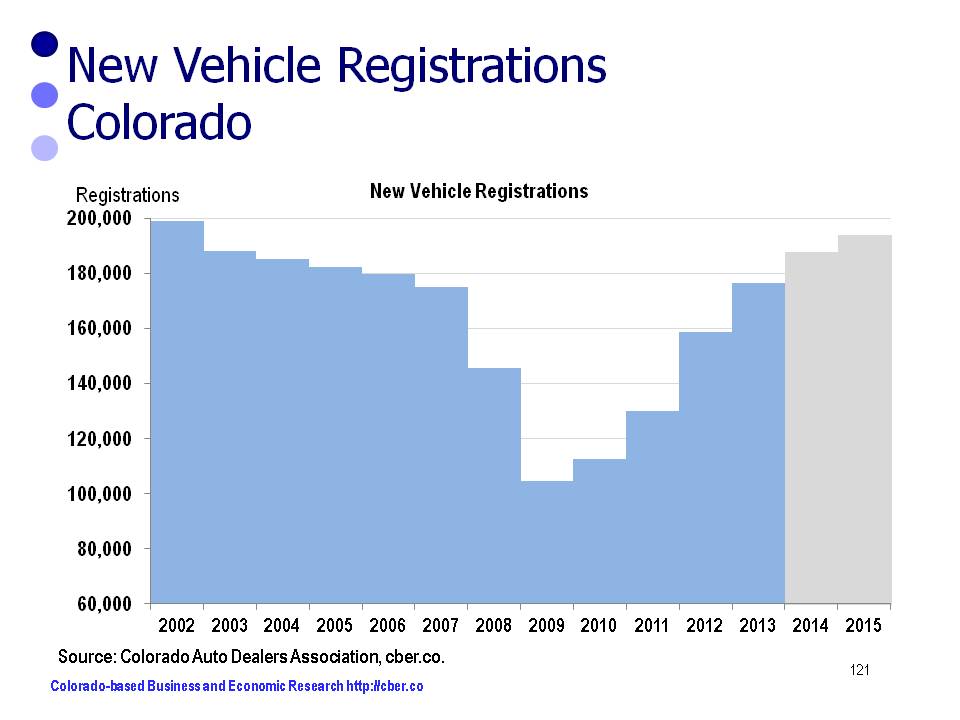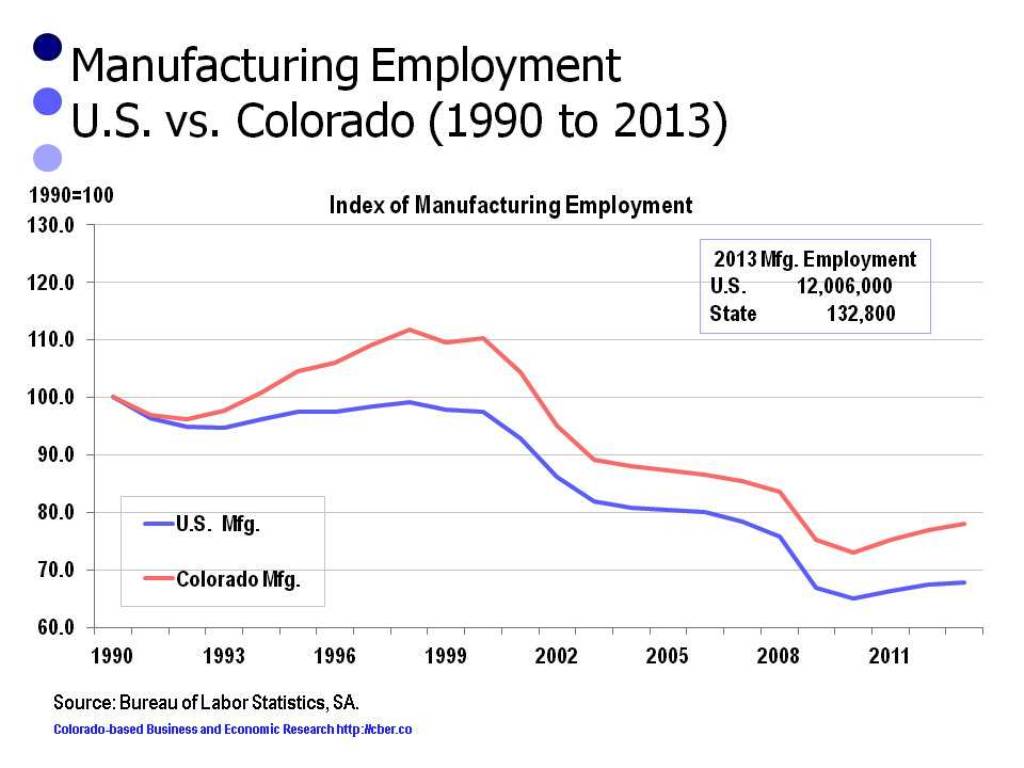Thank goodness for the mining and real estate industries! From an output perspective these industries are the primary drivers of the Colorado economy.
In 2013, Colorado’s nominal GDP was $294.4 billion (most current data available). The state’s economy expanded by $157.1 billion between 1997 and 2013 (1997 is the first year that data was available). Between 2009 and 2013 the GDP expanded by $46.3 billion.
The Great Recession had a major impact on the way the economy expanded. This is evident when comparing the contribution to output for the periods 1997 to 2013 and 2009 to 2013.
Between 1997 and 2013 the contribution to GDP was broken down as follows:
• Goods Producing 20.5%
• Service Producing 68.6%
• Private sector (Goods + Services) 89.0%
• Government 11.0%
Between 1997 and 2013 the annualized rate of growth for the GDP follows:
• Total 4.9%
• Private 5.0%
• Government 4.1%
Between 2009 and 2013 the contribution to GDP was broken down as follows:
• Goods Producing 28.0%
• Service Producing 65.5%
• Private sector (Goods + Service) 93.6%
• Government 6.4%
Between 2009 and 2013 the annualized rate of growth for the GDP follows:
• Total 4.4%
• Private 4.7%
• Government 2.2%
Thank goodness for the Goods Producing Sectors (Agriculture, Mining, Construction, and Manufacturing)!
| Industry |
2013 GDP (millions) |
2013 minus 1997 |
% of Total |
2013 minus 2009 |
% of Total |
|---|
| All industry total |
$294,443 |
$157,072 |
|
$46,266 |
|
| Private industries |
$258,217 |
$139,860 |
89.0% |
$43,287 |
93.6% |
| Goods Producing |
$57,447 |
$32,144 |
20.5% |
$12,964 |
28.0% |
| Service Producing |
$200,771 |
$107,718 |
68.6% |
$30,325 |
65.5% |
| Government |
$36,226 |
$17,212 |
11.0% |
$2,979 |
6.4% |
The following two tables provide more detail by industry.
The following table shows more detail by industry sector. It is sorted in descending order by the column 2013 minus 1997.
| Industry |
2013 GDP (millions) |
2013 minus 1997 |
% of Total |
2013 minus 2009 |
% of Total |
|---|
| Real estate and rental and leasing |
$40,194 |
$21,355 |
13.6% |
$6,895 |
14.9% |
| Mining |
$19,848 |
$17,964 |
11.4% |
$8,518 |
18.4% |
| Government |
$36,226 |
$17,212 |
11.0% |
$2,979 |
6.4% |
| Professional, scientific, and technical services |
$26,355 |
$16,084 |
10.2% |
$4,233 |
9.1% |
| Information |
$21,578 |
$12,019 |
7.7% |
$1,407 |
3.0% |
| Health care and social assistance |
$17,438 |
$10,503 |
6.7% |
$2,262 |
4.9% |
| Wholesale trade |
$15,915 |
$7,818 |
5.0% |
$2,606 |
5.6% |
| Retail trade |
$16,105 |
$6,926 |
4.4% |
$1,965 |
4.2% |
| Manufacturing |
$21,600 |
$6,657 |
4.2% |
$2,171 |
4.7% |
| Finance and insurance |
$14,480 |
$6,067 |
3.9% |
$2,436 |
5.3% |
| Accommodation and food services |
$9,409 |
$5,255 |
3.3% |
$1,769 |
3.8% |
| Management of companies and enterprises |
$6,207 |
$5,106 |
3.3% |
$1,550 |
3.4% |
| Construction |
$11,820 |
$4,861 |
3.1% |
$208 |
0.4% |
| Administrative and waste management |
$8,653 |
$4,308 |
2.7% |
$1,090 |
2.4% |
| Transportation and warehousing |
$7,984 |
$4,094 |
2.6% |
$1,598 |
3.5% |
| Other services |
$6,549 |
$2,784 |
1.8% |
$605 |
1.3% |
| Agriculture, forestry, fishing, and hunting |
$4,179 |
$2,662 |
1.7% |
$2,067 |
4.5% |
| Arts, entertainment, and recreation |
$3,848 |
$2,029 |
1.3% |
$890 |
1.9% |
| Utilities |
$3,798 |
$1,782 |
1.1% |
$646 |
1.4% |
| Educational services |
$2,258 |
$1,588 |
1.0% |
$373 |
0.8% |
The following table shows more detail by industry sector. It is sorted in descending order by the column 2013 minus 2009.
| Industry |
2013 GDP (millions) |
2013 minus 1997 |
% of Total |
2013 minus 2009 |
% of Total |
|---|
| Mining |
$19,848 |
$17,964 |
11.4% |
$8,518 |
18.4% |
| Real estate and rental and leasing |
$40,194 |
$21,355 |
13.6% |
$6,895 |
14.9% |
| Professional, scientific, and technical services |
$26,355 |
$16,084 |
10.2% |
$4,233 |
9.1% |
| Government |
$36,226 |
$17,212 |
11.0% |
$2,979 |
6.4% |
| Wholesale trade |
$15,915 |
$7,818 |
5.0% |
$2,606 |
5.6% |
| Finance and insurance |
$14,480 |
$6,067 |
3.9% |
$2,436 |
5.3% |
| Health care and social assistance |
$17,438 |
$10,503 |
6.7% |
$2,262 |
4.9% |
| Manufacturing |
$21,600 |
$6,657 |
4.2% |
$2,171 |
4.7% |
| Agriculture, forestry, fishing, and hunting |
$4,179 |
$2,662 |
1.7% |
$2,067 |
4.5% |
| Retail trade |
$16,105 |
$6,926 |
4.4% |
$1,965 |
4.2% |
| Accommodation and food services |
$9,409 |
$5,255 |
3.3% |
$1,769 |
3.8% |
| Transportation and warehousing |
$7,984 |
$4,094 |
2.6% |
$1,598 |
3.5% |
| Management of companies and enterprises |
$6,207 |
$5,106 |
3.3% |
$1,550 |
3.4% |
| Information |
$21,578 |
$12,019 |
7.7% |
$1,407 |
3.0% |
| Administrative and waste management |
$8,653 |
$4,308 |
2.7% |
$1,090 |
2.4% |
| Arts, entertainment, and recreation |
$3,848 |
$2,029 |
1.3% |
$890 |
1.9% |
| Utilities |
$3,798 |
$1,782 |
1.1% |
$646 |
1.4% |
| Other services |
$6,549 |
$2,784 |
1.8% |
$605 |
1.3% |
| Educational services |
$2,258 |
$1,588 |
1.0% |
$373 |
0.8% |
| Construction |
$11,820 |
$4,861 |
3.1% |
$208 |
0.4% |

